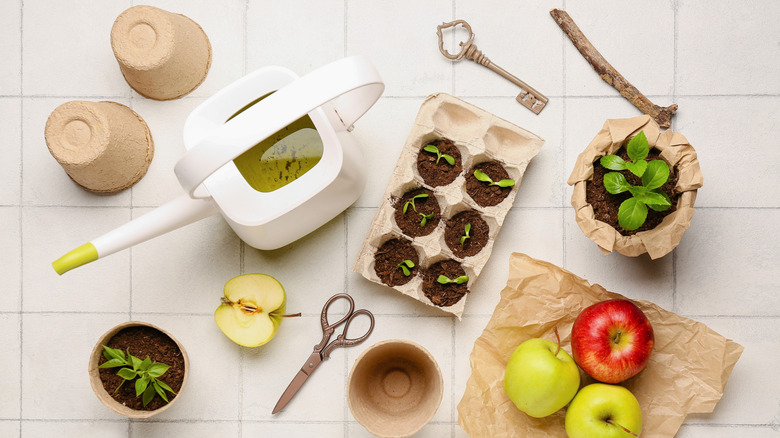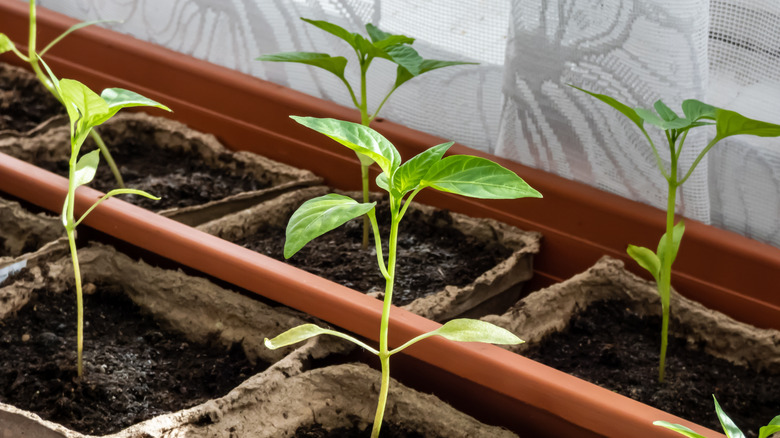Grow Healthy Seedlings And Soil With These DIY Cardboard Biodegradable Seed Starting Pots
Earth-conscious gardeners are always looking for ways to upcycle everyday items into useful aids for the garden. This prevents stuff from ending up in landfills and also means you save money by making supplies at home. As there are plenty of fruits and vegetables that are easy to grow from seed, here's a clever idea from Instagram user Joesgarden on how to repurpose those empty cardboard boxes that might otherwise end up in your recycling bin: Make them into DIY biodegradable seed starting pots, similar to those small peat pots you can buy from stores. You likely have all the supplies you need already. In addition to cardboard, you'll need something cylindrical–like a tin can–to wrap it around, rubber bands, and a vessel filled with water. Not only will these allow you to grow healthy seedlings, but they'll also enrich your soil as they eventually break down.
If you've been gardening for a while, you're probably painfully aware that sowing seeds directly into beds can have mixed results. Sometimes, your seeds will germinate and grow, but more often than not, you'll either end up with minimal sprouting or you'll have so many come up in the same spot that it can be difficult and time-consuming to thin them out. On top of that, if you have a slug or snail problem, your tender seedlings might simply disappear overnight. This is enough to discourage even the most avid gardener, but there is a better way. When you start seeds in biodegradable pots, you can look after them more closely and plant well-grown seedlings in the garden without disturbing their roots.
How to make your own biodegradable seed starting pots from cardboard
After collecting some cardboard boxes, the first thing you want to do is remove all the tape and any labels so that all you're left with is plain cardboard. As a side note, don't use any boxes with a plastic or wax coating. Soak the cardboard in water for around 10 minutes or so to make it pliable and easy to work with. While the cardboard is still wet, cut it into strips that are about 5 to 6 inches wide. If you're planning to grow root crops like carrots, you might want these a bit wider so the resulting pot is deep enough to accommodate a nice, healthy tap root. Even though root vegetables are one of those plants that you shouldn't start growing indoors, if your DIY pots are tall enough and transplanted straight into the garden without disturbing the roots, you should have success with these.
Wrap each damp strip around a tin or jar and secure it with a rubber band. Make sure you leave some excess at the base that you can push into shape for the bottom of the pots. You could also use empty wine or condiment bottles as molds to make deeper pots. In fact, you might want to experiment with different molds to get just the right-sized containers. Leave the pots in a warm spot until the cardboard is completely dry. Then, remove the molds, and your pots are ready for planting.
How to use the pots you've created
When you're ready, fill the pots with a seed-starting mix and sow your seeds. As these will be planted straight into the garden, you only want to sow one or two seeds into the center of each pot, so you end up with one plant per pot. At this point, you might be interested in some tricks to increase the seed germination rate for a flourishing garden. Take care when watering so you don't get the pots too wet, or they'll fall apart. It's best to use a long-spouted watering can and aim the liquid directly at the soil. You might even want to take extra precautions and place your pots inside a shallow plastic container with plenty of drainage holes. Put them right up against each other to help maintain their structure.
When the seedlings are ready for transplanting, dig a hole large enough to accommodate the entire pot. Make sure the cardboard doesn't stick up above the soil level because this is likely to act as a wick and take moisture away from the plant roots. Over time, the cardboard will break down and enrich your soil with carbon. You'll also find that earthworms are particularly attracted to this material, and the more worms you have in your yard, the healthier your soil will be. These garden helpers will efficiently aerate the soil and leave behind nutritious castings to help feed your plants. As a final tip, you can use empty toilet paper rolls for seed pots as well.

